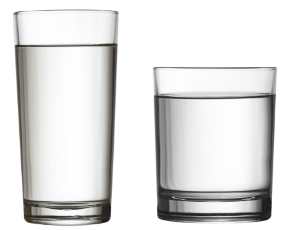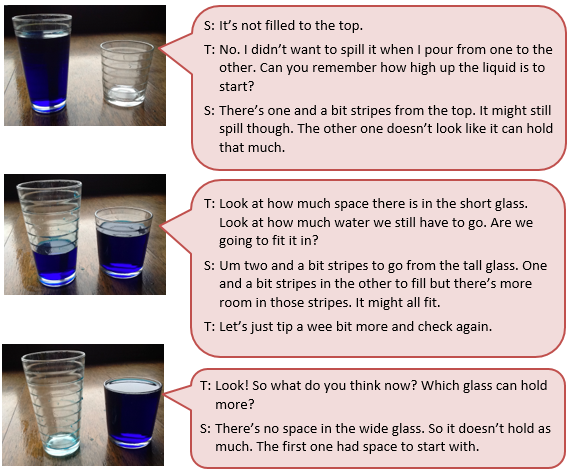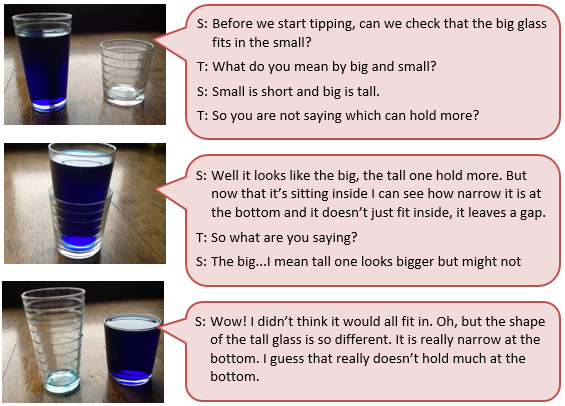The purpose of this activity is to engage students in estimating and comparing the capacity of objects with different dimensions.
This activity assumes the students have experience in the following areas:
- Sorting and ordering objects by size.
- Filling containers to find out which one holds most water.
- Recognising that taller containers don’t always hold more than shorter containers.
- Using words to describe the characteristics of containers, such as tall/short, wide/skinny, etc.
The problem is sufficiently open ended to allow the students freedom of choice in their approach. It may be scaffolded with guidance that leads to a solution, and/or the students might be given the opportunity to solve the problem independently.
The example responses at the end of the resource give an indication of the kind of response to expect from students who approach the problem in particular ways.
One of these glasses is tall and skinny. The other is short and fat.
Which of these two glasses would you choose if you wanted the one that holds the most liquid?
Note to teacher: Any two cups or glasses could be used. Ideally, they should have different dimensions but similar capacity. A staffroom mug and a paper cup could be used.
The following prompts illustrate how this activity can be structured around the phases of the Mathematics Investigation Cycle.
Make sense
Introduce the problem. Allow ākonga time to read it and discuss in pairs or small groups.
- What do you think the problem is about?
- What information has been given?
- What do you need to find out?
- Can you rephrase the problem in your own words? (Which of the two glasses holds the most?)
- How will you know when you have answered the problem? (Student must identify which glass holds most and be able to justify how they know that is true.)
Plan approach
Discuss ideas about how to solve the problem. Emphasise that for now you want ākonga to say how they would solve the problem, not to actually solve it.
- How can you compare the amount the two glasses hold?
- Is there something else that you can use to measure the amount each one holds?
The most likely approach to choose is to fill one glass with water and pour it into the other. Students may suggest physically placing one glass inside the other. The glasses chosen should make that approach difficult.
Take action
Allow ākonga time to work through their strategy, and find a solution to the problem.
- What do you need to use to help you solve the problem?
- Are you writing or drawing anything? How does that help you?
- How can you check your answer?
- You used a measurement jug. How do you know how much each glass holds?
- Does your solution answer the question?
Convince yourself and others
Allow ākonga time to check their answers and then either have them pair share with other groups or ask for volunteers to share their solution with the class.
- How do we know if the answer is correct?
- What would happen if you filled the other glass first?
- What could you try differently next time?
- Would this help you solve a similar problem?
- How would you put more than two glasses in order by how much they hold?
- What might you do differently next time?
Examples of work
Work sample 1
The student uses visual clues to compare the dimensions of different objects and to uses these observations to estimate possible differences in capacity.
Click on the image to enlarge it. Click again to close.
Work sample 2
The student considers the shape and/or dimensions of different objects and to use these observations to estimate possible differences in capacity.


